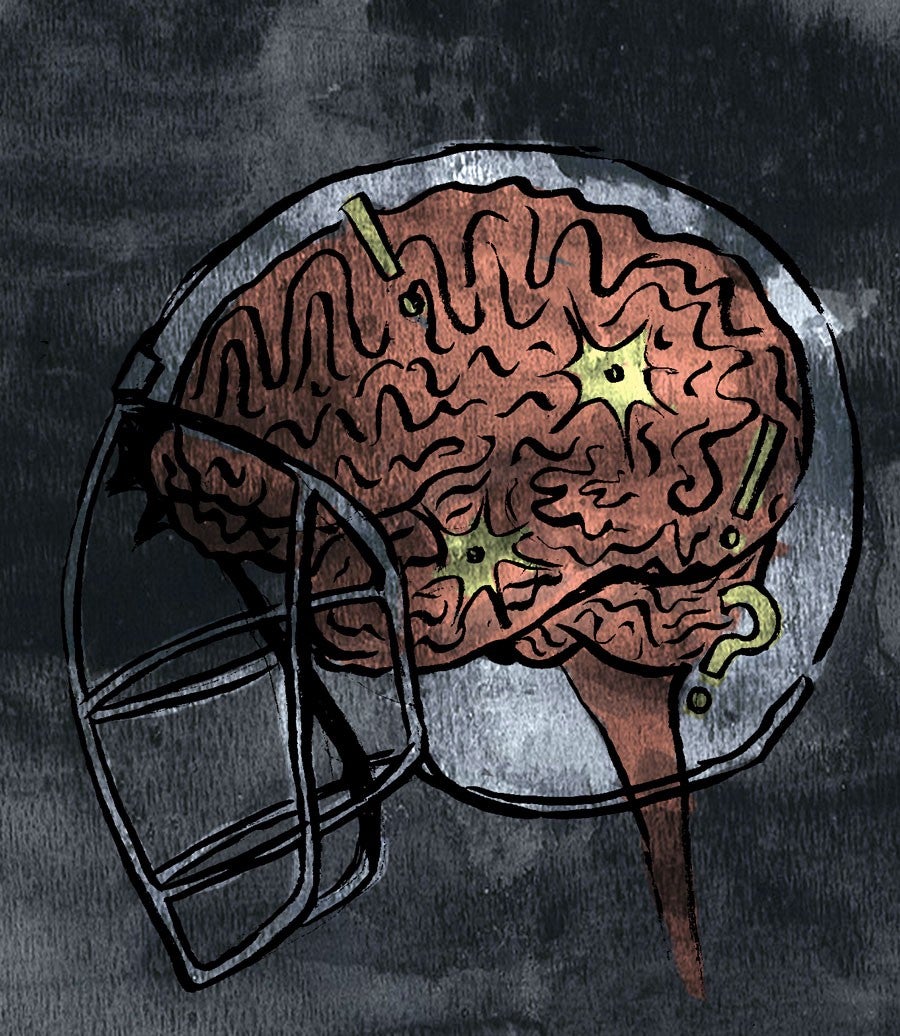On his daughter Christine’s 18th birthday in 2005, Tom Baugh calmly sat down with her, his wife and his second daughter, and told them he wanted to kill himself.
It was the nadir of Baugh’s rapid descent into depression. “I was ready to die. And willing,” Baugh says. For most of his life, Baugh was calm, grounded and successful — first as a professional football player for the Kansas City Chiefs, Cleveland Browns and Detroit Lions, and later as a high school football coach, educator and entrepreneur. NFL players are notorious for going broke after leaving the league, but Baugh flourished after his retirement from football in 1990. He returned to his hometown of Riverside, Illinois, where he taught shop and coached football at his high school alma mater. He started exercising regularly and dropped 50 pounds to reach 247, the lightest he had been since high school. He had two daughters with his high school sweetheart, Jeannie, and in 1998 moved with his family to a five-acre rural estate outside Kansas City — the city he and Jeannie had fallen in love with when he played for the Chiefs. There, he took a job at a construction firm and eventually became its owner.
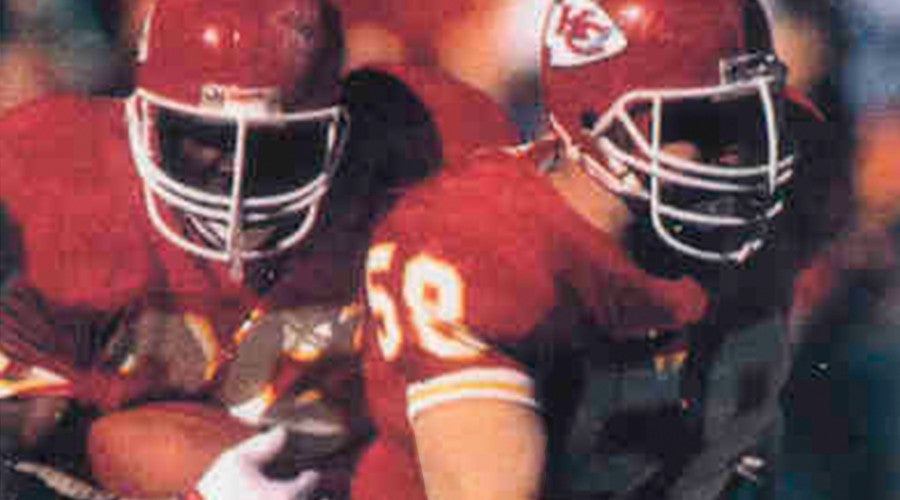
But everything changed in 2004. Baugh suddenly grew irritable, lashing out at his family for the smallest infractions. He’d berate his daughters if they arrived somewhere five minutes late. He once found a high utility bill and pounded the kitchen table, screaming, “We don’t need this kind of shit!” If the phone rang unexpectedly, he’d respond by whipping the nearest object against the wall. After an outburst, he would isolate himself somewhere dark and quiet — in the workshop in his barn, where he worked at carpentry and metallurgy; or in the basement of the house, where he would sit in his rocking chair, thinking of a way to escape his family. “I didn’t like outside,” he says. “The birds, the wind — too much stimulus.”
Baugh’s decline is archetypal for NFL players of his era — men who had their bodies break down on the field, only to have their minds crumble after they left it. More than a decade’s worth of neurological research on former NFL players has drawn a near-irrefutable link between brain injuries suffered playing football and subsequent cognitive decline. Even the NFL, whose doctors spent the better part of the 2000s arrogantly dismissing such a connection, has reluctantly acknowledged that the violence of the game results in the mental deterioration of its players.
Several illnesses have garnered attention, most notably chronic traumatic encephalopathy (CTE), a degenerative brain disease that can result in aggression, memory loss and suicide. Evidence of CTE has been found in more than 95 percent of the brains of NFL players studied posthumously. Meanwhile, NFL retirees report abnormally high rates of Alzheimer’s, dementia, Parkinson’s and ALS (Lou Gehrig’s disease). The connection between football and neurological disease has been the subject of a flood of news stories, two documentaries, a book, a Congressional hearing and, most recently, the Hollywood film Concussion. Currently, the NFL is trying to finalize an out-of-court settlement with former players suffering from certain neurological diseases, a payout estimated at $1 billion.

Doctors attribute Baugh’s mental problems to the countless head injuries he suffered as a player, but he stands to earn nothing from the settlement. He shows no signs of ALS, he has not been formally diagnosed with Alzheimer’s or Parkinson’s, and it’s impossible to know if he has CTE. Baugh has been diagnosed with a lesser-known condition called hypopituitarism, making him one of thousands of former players who suffer from brain damage but will not be compensated by the league’s settlement. And his story suggests that at least one team in the NFL was concerned about the long-term effects of brain trauma on football players as far back as 1990, 19 years before the NFL acknowledged any link existed.
In 2009, Baugh was contacted by a team of medical researchers led by Dr. Daniel Kelly — a neurosurgeon at Providence Saint John’s Health Center in Santa Monica, California — about participating in a study on hypopituitarism among NFL retirees. The pituitary gland regulates production of testosterone and human growth hormone (among other hormones). When those levels decline, depression, weight gain, erectile dysfunction, fatigue and anxiety often follow. “In general, people with low growth hormone tend to feel worse,” says Garni Barkhoudarian, a neuroscientist on Kelly’s team and co-author on the study. “They just say, ‘I feel lousy.’”
Pre-existing research showed pituitary dysfunction occurred in 20 to 40 percent of people who had suffered moderate to severe traumatic brain injury (typically in car accidents), so the researchers figured the same would be true for NFL retirees. A force of 100 Gs (i.e., 100 times the force of gravity) is enough to cause a concussion; 130 Gs is the equivalent of a severe car accident. The average NFL tackle generates 30 to 60 Gs of force, with the hardest collisions measuring 150 Gs — more than enough to ravage delicate parts of the brain. “The pituitary gland is at some risk compared to the rest of the brain because it’s kind of tethered in its own little area,” Barkhoudarian says. “Some of the brain moves in an injury, but [the pituitary] does not. The gland can get sheared off the brain or the blood supply can get damaged or it can bleed inside the gland.”

Baugh was an ideal candidate for the study: He had the symptoms, and he had suffered many concussions over the course of his football career, not to mention innumerable “subconcussive” hits. The team recruited another 429 players from a database of retired athletes and ended up studying 68 of them, including Baugh. The study painted retired NFL players as overweight, depressed and impotent as it reported high rates of obesity, lethargy, erectile dysfunction and an overall poor quality of life. In all, 41.2 percent of the subjects were deficient in growth hormone, a sign of hypopituitarism. Adjusted for body mass index, 23.5 percent had hypopituitarism — rates comparable to those found among ordinary brain trauma patients.
But the researchers were surprised to learn the participants with hypopituitarism did not report having suffered more concussions than those with normal hormone levels. At first glance, this might seem to indicate football doesn’t increase the risk of hypopituitarism, but it actually suggests an even more alarming conclusion: If the high rate of hypopituitarism can’t be attributed to concussions, then it could be due to the accumulation of minor impacts from “safe” and routine hits over the course of a career. These subconcussive hits are so subtle players might not experience symptoms at the time, according to Barkhoudarian. “It is possible that multiple subconcussive impacts sustained over a long career could lead to eventual hormonal dysfunction,” he and his collaborators theorized when the study was published in the Journal of Neurotrauma in July 2014.
Similar studies have connected hormone dysfunction and pituitary dysfunction to combat sports such as boxing, kickboxing and MMA; explosive blasts survived by soldiers; and non-sport-related injuries. While the study wasn’t the first to draw a link between subconcussive hits and brain disease, it was the first to connect it to pituitary dysfunction. “I suspect there are lots of people out there with post-concussion syndrome — people who participated in contact and collision sports — but what they really have is significant but untreated hypopituitarism,” says Vernon Williams, a sports neurologist in Los Angeles. “Hypopituitarism related to sports concussion is almost a silent epidemic.”
Baugh’s concussion history coincided with his introduction to football — his first occurred during his freshman year of high school. “I played the whole game but don’t remember any of it. I just ‘woke up’ after the game in the locker room with my uniform still on. The coach came in to turn off the lights and I was the only one left. He asked me what was wrong, and I asked him who won the game. He told me I probably had a concussion, but I should probably be all right.”
He went on to play center at Southern Illinois University, where he once suffered a concussion so severe the symptoms lasted for three weeks. “You’re in a fog. You don’t even know what you’re doing,” Baugh says of being concussed. “You’re there, you’re existing, you’re living… but you’re not making conscious decisions. You’re just acting out habit or whatever.” Jeannie remembers Baugh being so dazed after the hit that he nearly stepped in front of an oncoming train. “We had a train track in town, and we had to sometimes cross to get to our classes,” she says. “And the bell would be ringing and he’d be crossing — just oblivious to a train coming.”
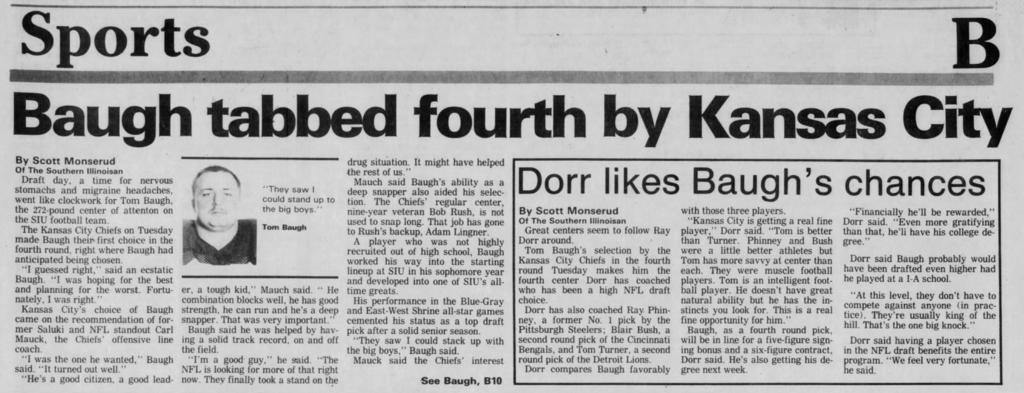
Baugh’s play, though, was unaffected — he was selected by the Kansas City Chiefs in the fourth round of the 1986 draft, exceptional for a player from a Division I-AA school.
In all, Baugh remembers 15 times over the span of his football career (high school and college included) when a hit left him with severe dizziness or some degree of amnesia — telltale signs of a concussion. Like many players from his era, Baugh felt pressured to play through these injuries, as he described in a journal entry about his time with the Chiefs:
Head injuries are scary when you get them but there is no sympathy in the NFL. … A seemingly wimpy thing like a concussion that goes away after a short while (I’ve had some last 3 days) simply isn’t valid reason to be left off the hook. In fact you would probably be released from the team if you admitted to having them. So nobody admitted it. We just carried on as if it was a hangnail. … I bet I played maybe 2–5% of my NFL plays in an altered state from concussion. [All sic.]
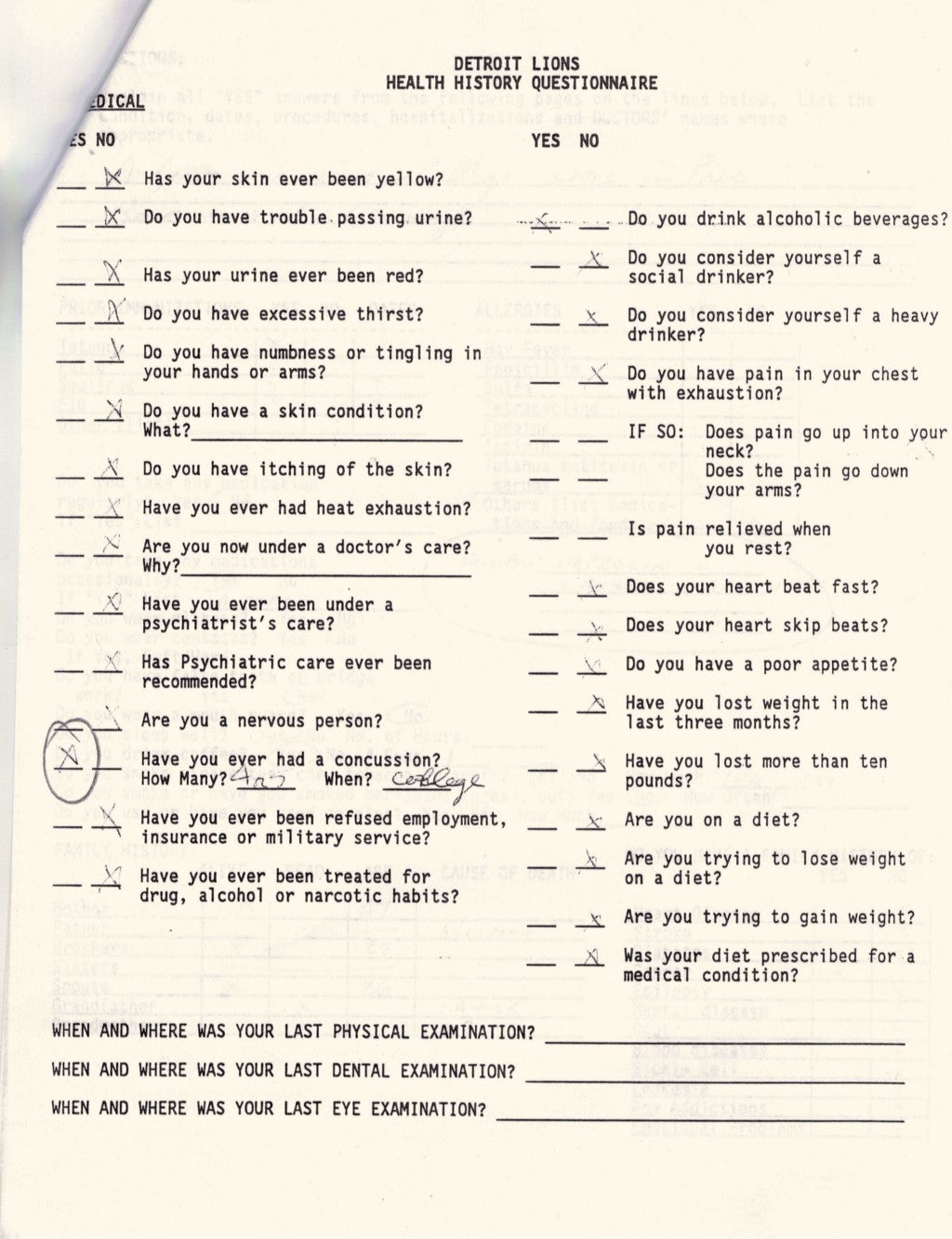
Baugh’s last concussion came in the summer of 1990. After three years with the Chiefs, Baugh spent a disappointing season with the Cleveland Browns before getting cut just before the start of the 1990 season. The Detroit Lions quickly signed Baugh off waivers, and he reported to Lions training camp in July. There he underwent the standard physical for new players, and his only health concern at the time was the tendonitis in his right knee. “They bend every finger, joint, knee, ankle,” Baugh says, but they mostly neglect one major organ: “They didn’t give you a brain physical.” The extent of the Lions’ brain injury assessment was a single line on a one-page questionnaire asking if Baugh had suffered any previous concussions. He reported having had four in college, and the Lions cleared him to play.
Baugh was thrilled. “I’m pretty excited about going to Detroit, mostly because I’m getting out of Cleveland but also because I have another shot at another year of big money,” Baugh wrote in his diary on July 16, 1990. “Who knows, maybe it will turn into a job that lasts for years? I hope so because I know that I’m better than many of the centers in the NFL.”
Less than a month later, he was out of the league for good.
Baugh doesn’t remember the hit that ended his career. All he knows is that it happened on August 9, 1990, during the Lions’ first preseason game against the Houston Oilers. “I realize there was a game, and I realize I was in it. When the concussion happened or how it happened, I don’t remember.” According to the Lions medical file on Baugh, which Baugh provided for this story, the Lions’ head trainer, Kent Falb, recorded Baugh was experiencing “mild retro-grade [sic] amnesia” in the fourth quarter and allowed him to continue playing. After the game, Falb wrote Baugh was “negative” for concussion symptoms and pledged to reassess him the following day. But Baugh says the follow-up never took place.
Two days later, Baugh reported to the Lions’ training facility, where he says he was confronted by a Lions employee he had never seen before. “Some young kid came up to me and said, ‘Here, they want you to sign this,’” Baugh recollects. He read the document, and was puzzled by one line in particular: “‘The Detroit Lions will no longer be liable for my head injuries.’ I said, ‘What does this mean? If I’m in a coma on the 50-yard line my wife’s gotta pick me up, or what?’ And the kid didn’t know anything about it. He kinda shrugged his shoulders, and I said, ‘I’m not signing this.’”
At that, the employee presented a second document, Baugh claims. It was a letter detailing his release. Baugh says he signed it, ending his tenure with the Lions.
“I might be more damaged than even I want to admit, at least I didn’t sign my head away,” reads Baugh’s journal entry from that day.
After the Lions released Baugh, Falb entered the following into Baugh’s medical file [emphasis added]:
This player was released from the Detroit Lions at 9:00AM on this date. The player had received a blow to his head in the ball game on 8–9 with some retrograde amnesia. Post game the player was asymptomatic with normal vision and no headache reported. Player was not seen for any reason on 8–10 which was the players day off.
Therefore, when the player was terminated he was, to the best of our knowledge, asymptomatic. He was suffering from no other known or reported physical injuries or medical problems and was fully capable of participation in professional football. [All sic.]
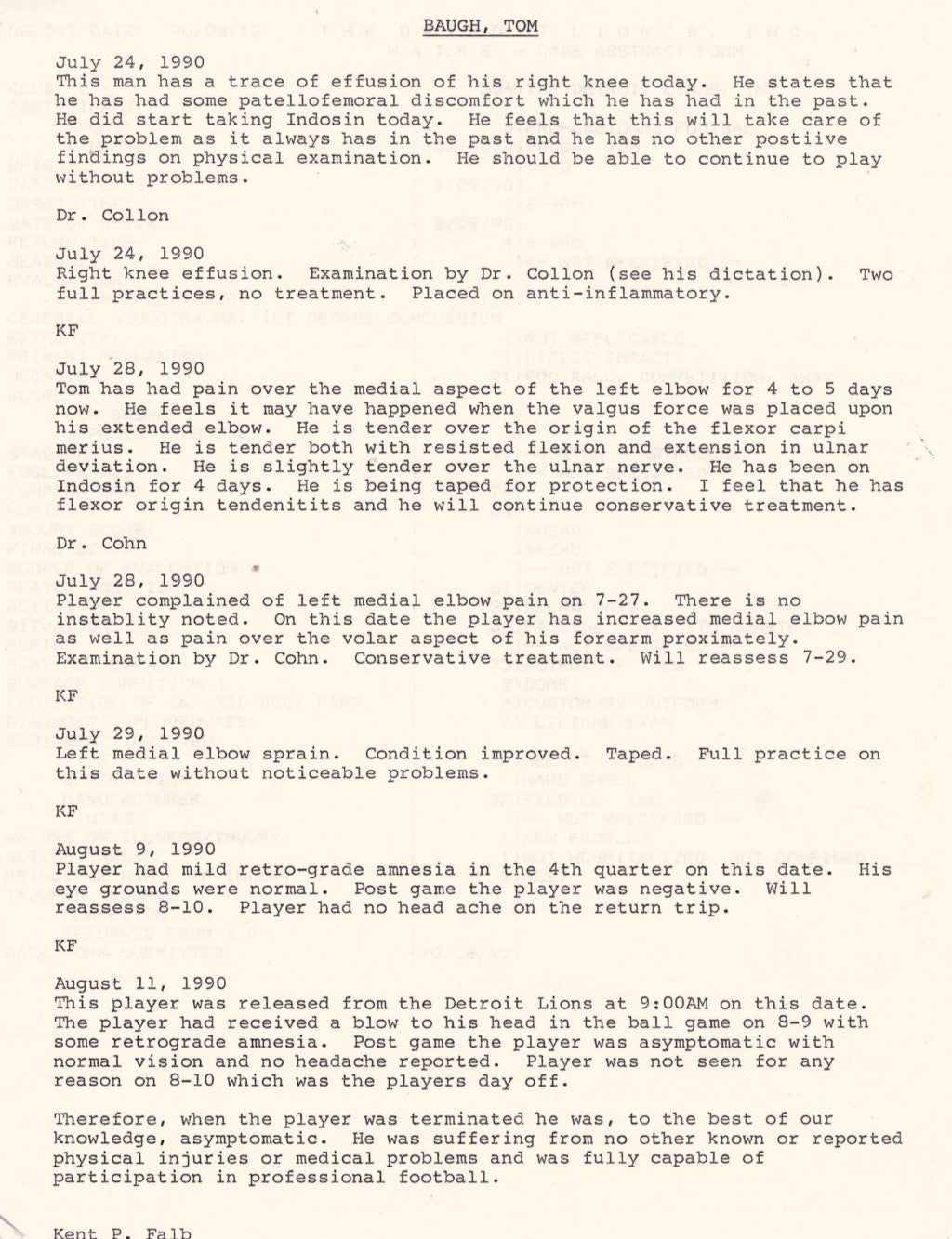
If true, the Lions’ actions were incongruous: The waiver implies the team was not only worried about the long-term effects of Baugh’s brain injuries, but actively tried to shield itself against potential damages. Meanwhile the Lions’ training staff was prepared to rule Baugh safe to play (just as long as the team wouldn’t be held responsible for any head injuries he might suffer). That is, the Lions deemed Baugh healthy even though their actions suggest they knew his brain was at some risk.
Falb declined to answer any questions about Baugh’s version of events, saying he didn’t want to rehash an event from more than 25 years ago. The NFL did not return repeated requests for comment, and the Lions say they are not permitted to discuss the matter due to the Health Insurance Portability and Accountability Act (HIPAA), which bars the organization from sharing its employees’ medical information.
Baugh says he was given a copy of his medical record upon release, but he did not hold onto the waiver. “If I had those documents today, I’d be a multimillionaire,” he says.
As it’s currently structured, the NFL’s out-of-court settlement will only compensate players who suffer from, or end up developing, the following neurological diseases: ALS, Alzheimer’s, dementia, Parkinson’s and some forms of CTE. Players are eligible for up to $5 million depending on the severity of their medical issues. The younger a player is diagnosed, and the more severe his impairment, the more he is entitled to, with the highest payouts going to the estates of young retirees whose autopsies reveal signs of CTE. But lost amid the ongoing legal, medical and cultural controversy are players such as Baugh, whose lives have been devastated by less-severe brain diseases, but who will not be compensated at all by the league.
The settlement is “binary,” according to a former NFL player who wishes to remain nameless. Players either have a major neurological condition and qualify for compensation, or they’re left out entirely.
That player is one of 220 who have opted out of the class action, thereby reserving the right to sue the league as individuals and seek compensation for less-severe brain injuries. The Brain Injury Association of America denounced the settlement in August in an amicus brief that says the settlement “neither recognizes nor compensates the majority of players suffering long-term consequences of brain trauma.” Meanwhile, about 90 players in the class action have appealed the settlement with the hope of making the compensation requirements less narrow.

Kimberly Archie, co-founder of Child Athlete Advocates, a sports injury awareness group, calls players such as Baugh the “invisible group.” “They don’t fit into one of the categories [listed in the settlement],” she says, but they suffer from a slew of diseases tied to brain trauma, including sleep apnea, seizure disorders, frequent migraines and pituitary dysfunction.
Former NFL linebacker Brendon Ayanbadejo hasn’t opted out of the class action but criticized the terms of the settlement. “There’s definitely always more the NFL can do,” Ayanbadejo says. “How do you figure out something … to help anybody and everybody that played in the league with whatever their problems are?”
Baugh opted out of the litigation, too, and he has no intention of suing the NFL as an individual, given the cost. “[The class action] is a farce. There’s no settlement for any of my issues. Why would you stay in if there are no benefits?”
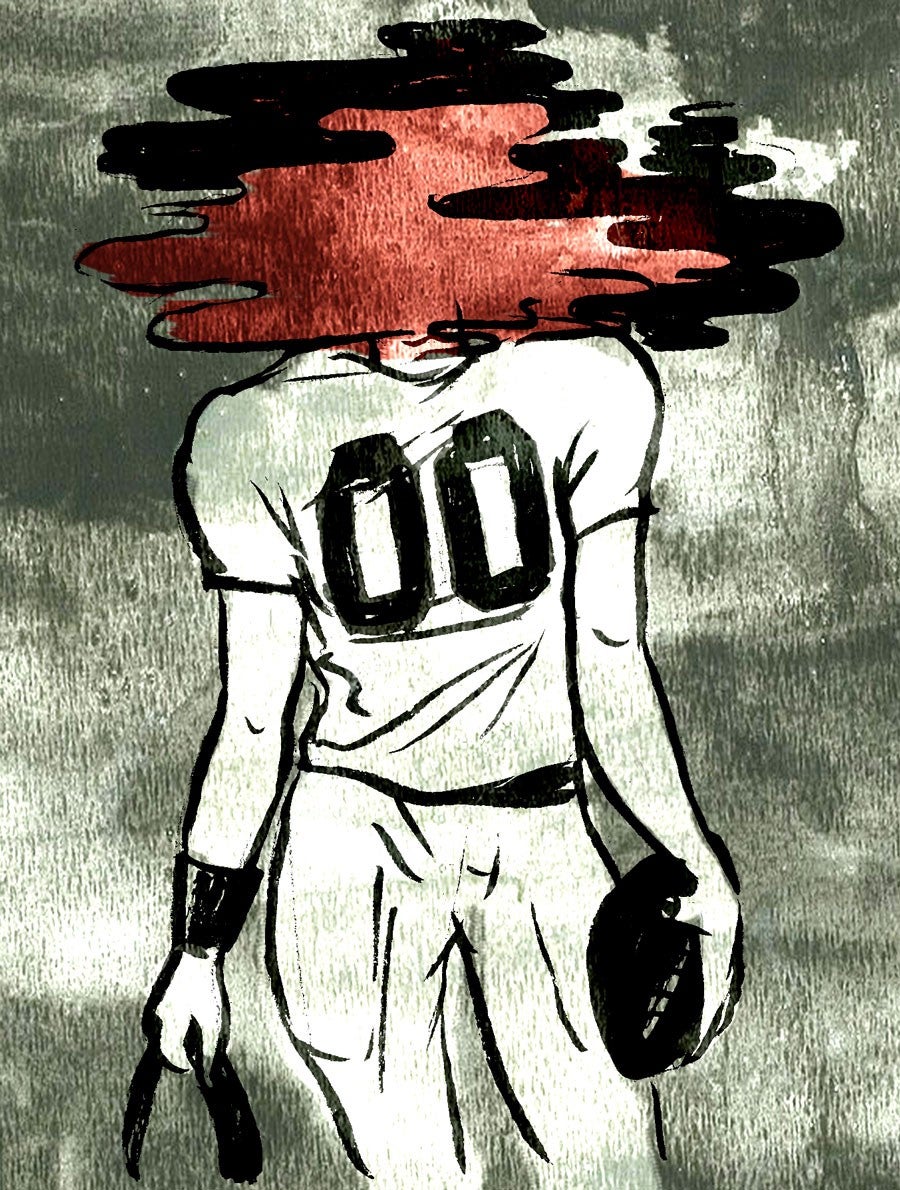
If Baugh were to sue, his story could have a “significant” impact on the class action deliberations, according to William Gibbs, a partner at Chicago law firm Corboy & Demetrio. The firm is representing several former NFL players in the class action suit, including the estate of Dave Duerson, the Chicago Bears safety who asked his family to donate his brain to CTE research before taking his own life in February 2011. (Three months after Duerson’s death, doctors found “indisputable evidence” of the disease in his brain tissue.)
“A team requesting a player waive his right to pursue a claim of any kind would and should be looked into,” Gibbs says of the Lions purported actions. “Particularly if it’s a team implicitly acknowledging long-term ramifications of head trauma at a time when others might have disputed it.”
Today, Baugh’s condition has improved since his 2005 low. He lashes out less and is more sociable, his wife says, but he has trouble maintaining his train of thought and is often confused and frustrated. He’ll get excited about an article he’s read, but will be unable to remember its contents moments later. He’ll try to do some woodwork in his shop, but he’ll take the boards to the construction site and they’ll be the wrong size. He’ll start on a house project, get sidetracked and never finish it.
Baugh experimented with a host of antidepressants after admitting to suicidal thoughts, eventually settling on Zoloft. It’s just one part of the cocktail of drugs he ingests, including Adderall (for focus), testosterone and human growth hormone (for his hypopituitarism), pills for his underactive thyroid, two allergy prescriptions and a gout medication. “I sound like I’m 90,” Baugh says of his drug intake. “Thing is, if you don’t take them, you’re friggin’ going off the deep end, y’know?”
Worse, the thought of suicide lingers. In death, Baugh might be diagnosed with CTE; only then would the NFL compensate him. “These guys and their families, some of them are potentially getting $5 million,” Baugh says. “I would die today for that.”
John McDermott is a staff writer at MEL. He recently wrote about a pair of Boston brothers who won $1 million playing fantasy football.
